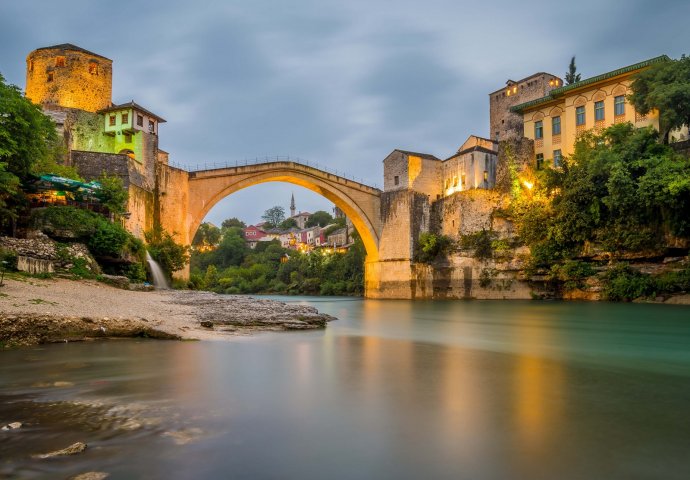Stari Most

Stari Most is a hump-backed stone arch bridge over the Neretva River in the city of Mostar, Bosnia and Herzegovina. Before it, there was a wooden suspension bridge at the same place. Ottoman geographer Katip Çelebi wrote that the old bridge"... was made of wood and hung on chains," and it"... swung so much that people crossing it did so in mortal fear."
In time, place grew and became an important link between the interior settlements and the Adriatic Sea, so in 1557 Suleiman the Magnificent realized Mostar's strategic position and ordered the construction of a new stone bridge. Order fell on Mimar Hayruddin, chief Ottoman architect student-Mimar Sinan, under the threat of death if construction fails.
Little is known about the construction flow, only that it lasted nine years. At that time, when the bridge was finished, it was the bridge with the largest arch in the world. It had no foundations to lean on. Just calcareous abutments, which secure the bridge to the cliff walls. Construction was supervised by Karagoz Mehmet Bey, the son-in-law of Sultan Suleyman.
Bridge was 29 meters long, 24 meters high, 4 meters wide. It had two fortified defense towers on each side.
Stories said the bridge had metal pins and egg white proteins together. They also said that on the day the construction ended and scaffolding was to be taken down, Mimar Hayruddin, the bridge architect prepared for his funeral. That bridge has been in perfect shape for 427 years. It was destroyed on 9 November 1993 during the war in Bosnia and Herzegovina. After the war, the decision was made to reconstruct the bridge as similar as it could be done with the same materials and the same tehnology.
In October 1998, UNESCO formed an international committee of experts to oversee the bridge's design and reconstruction work. Work began on 7 June 2001 by the Turkish company "Er - Bu Construction Corp," which specialized in the reconstruction of old Ottoman bridges with old techniques. Local tenelija calestone that was also used in the original bridge was used for material. Professional divers helped and recovered the original stones left in the river after the explosion, and these stones were also used as material. The reconstruction was completed on July 23, 2004.